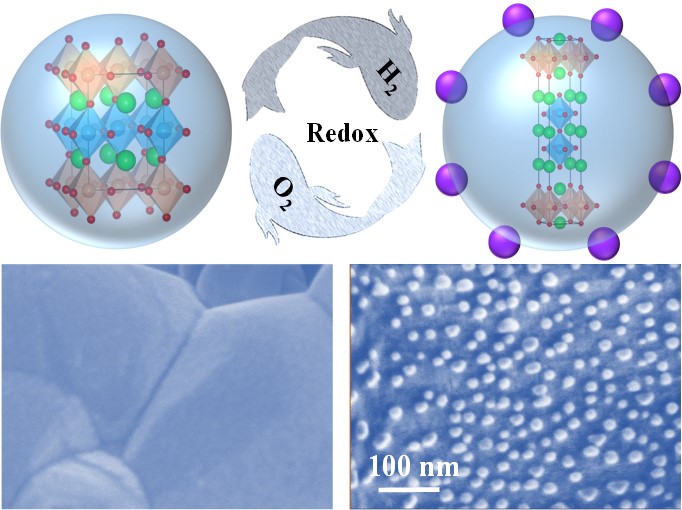A research team led by Prof. WANG Guoxiong and Prof. BAO Xinhe from the
Dalian Institute of Chemical Physics (DICP) of the Chinese Academy of Sciences revealed the reversible exsolution/dissolution mechanism of CoFe alloy nanoparticles in Co-doped Sr
2Fe
1.5Mo
0.5O
6-δ perovskite cathode in solid oxide electrolysis cell (SOEC) for CO
2 electrolysis. The results were published in
Advanced Materials.
Reversible Exsolution/Dissolution of CoFe Alloy Nanoparticles in Co-doped Sr2Fe1.5Mo0.5O6-δ Cathode for CO2 Electrolysis (Image by LV Houfu)
SOECs can convert CO2 and H2O to syngas, hydrocarbon fuel at cathode and pure oxygen at anode. They have the advantages of possessing solid and modular structure, fast reaction kinetics, high energy efficiency and low cost. Therefore, SOECs are promising in CO2 conversion and surplus renewable electricity storage.
Perovskites have been considered as the most promising cathode materials for direct CO2 electrolysis in SOEC in the absence of protective gas, but many of them still suffer from insufficient CO2 electrolysis performance. In situ exsolving metal nanoparticles on the surface of perovskite have been explored as an efficient strategy to improve CO2 electrolysis performance.
Although some perovskites have demonstrated redox reversibility with exsolution and dissolution of metal nanoparticles in reducing and oxidizing atmosphere, fundamental understanding of these phenomena is still scarce.
In this study, the researchers took advantage of in situ X-ray diffraction, in situ scanning transmission electron microscopy, environmental scanning electron microscopy and density functional theory calculations to investigate the exsolution/dissolution mechanism of CoFe alloy nanoparticles in Sr2Fe1.35Mo0.45Co0.2O6-δ (SFMC) double perovskite.
They found that under reducing atmosphere, the facile exsolution of metallic Co promoted the reduction of Fe cation to generate CoFe alloy nanoparticles in SFMC, accompanying with the structure transformation from double perovskite to layered perovskite. Under oxidizing atmosphere, the spherical CoFe alloy nanoparticles were firstly oxidized to flat CoFeOx nanosheet, and then dissolved into the bulk accompanying with structure transformation from layered perovskite back to double perovskite.
After reduction, metal-oxide interfaces between the exsolved CoFe nanoparticles and SFMC substrate with oxygen vacancies were constructed, showing enhanced CO2RR performance and high stability. The CO2 electrolysis performance could be retrieved after 12 redox cycles due to the renewability of CoFe nanoparticles.
This work was supported by the National Natural Science Foundation of China, the National Key R&D Program of China and DICP.





